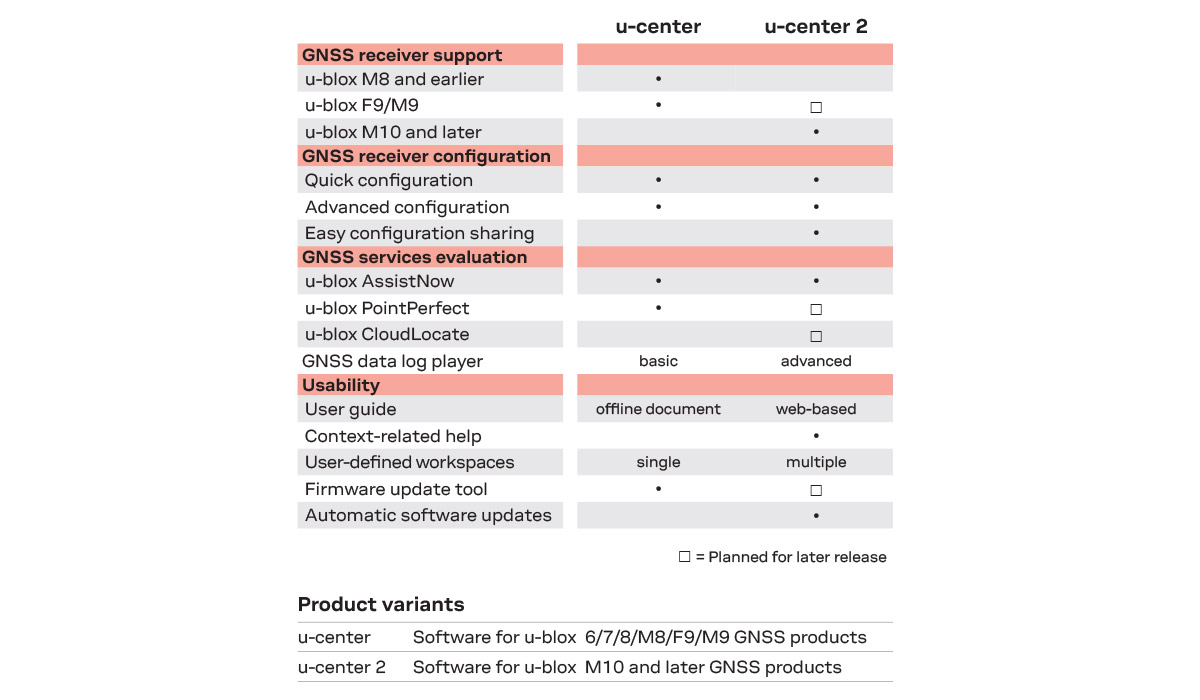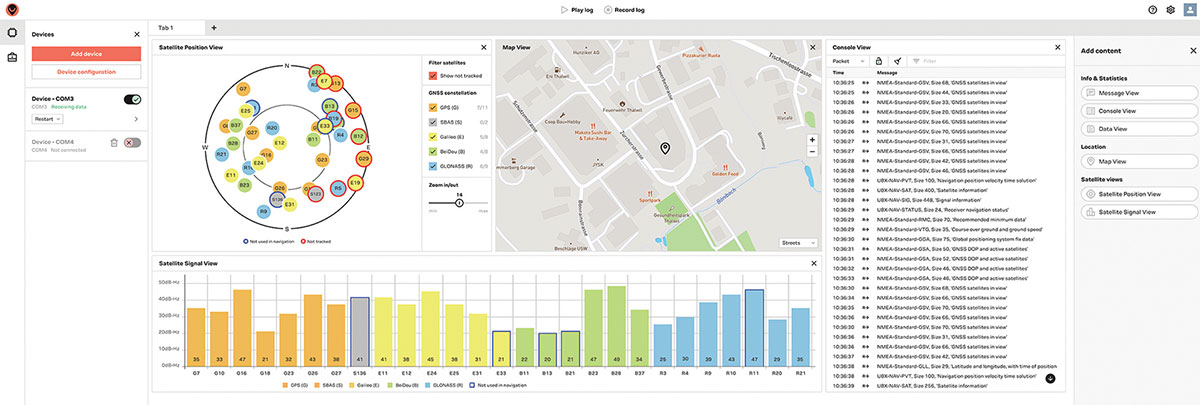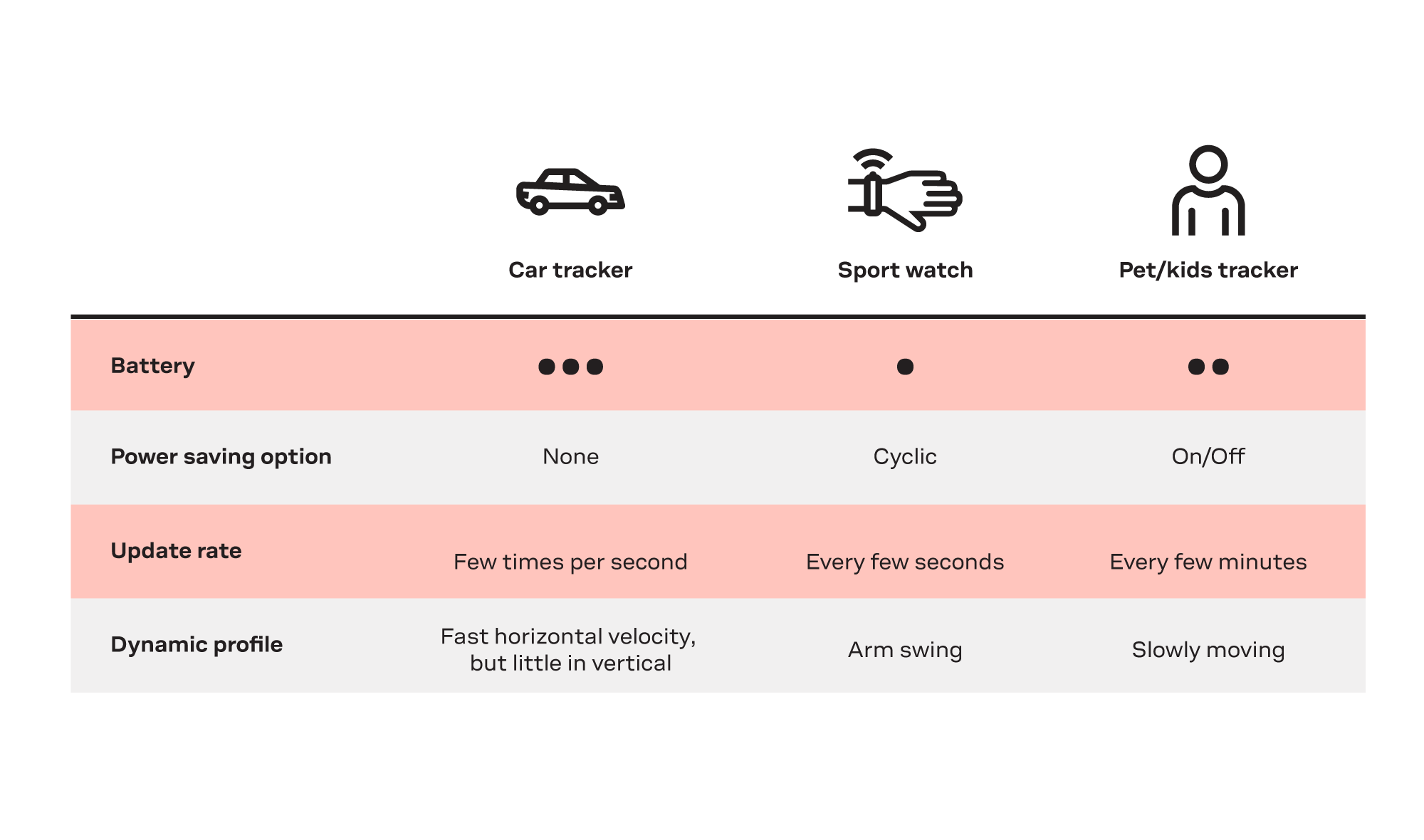
- Support portal
- Evaluation Kits and partner products
u-blox Support
- Product documentation
Documentation
- Investor relations
Investor relations
Tech
|
27 Sep 2022
u-center 2 is a highly intuitive software package from u-blox designed to evaluate GNSS performance and easily configure products by use case.

This software is a significant upgrade from the earlier u-center. The u-blox u-center 2 is compatible with the u-blox M10 GNSS products, while the legacy software will continue to serve previous product platforms.

Figure 1 - comparison between u-center and u-center 2
The workspace for u-center 2 provides several views to visualize the status and analyze the performance of the connected device. For example, field engineers can use the dataview to make a configuration change and evaluate the time to first fix (TTFF), which is the time the device takes to obtain its position on startup. The powerful logging functionality is helpful for users to record device messages during a field test and replay them later on in the office for deeper analysis.

Figure 2 - u-center 2 dashboard
GNSS (global navigation satellite system) devices have a complex set of configuration settings, which work together to optimize the performance of the device. Therefore, customers often do not even change the device configuration at all. This task is complex as optimizing a device for one criterion could influence another. For example, a faster update rate uses more power and reduces battery life.
As different applications need to fulfill different requirements, it is sometimes better to change the default configuration. Usage-based-insurance (UBI) vehicle trackers typically require high update rates to identify in case of harsh braking or crash events. On the other hand, wearable devices must consider the users arm swing movements and balance position accuracy with power consumption. However, the update rate can be much slower. People trackers require an even lower update rate, but position accuracy is still vital.
An interface description manual for a u-blox GNSS device can run into hundreds of pages and cover more than a thousand configuration options. The integration manual however gives some guideline about the most relevant settings, but not related to a certain use case. Programming a device by setting each parameter in isolation can be intimidating and time-consuming. A field engineer configuring a device from scratch would have to try out the effect of each parameter and how it interferes with other settings to optimize the device performance.

Figure 3 - u-center 2 device configuration window with presets, saved configurations and import function
Instead of working through the complete list of parameters individually to optimize performance, u-center 2 provides a subset of key configuration parameters for specific use cases. These parameters are preset to typical values for that use case, which is a good starting point.
There are three quick preset examples available in u-center 2:
1. Vehicle tracker
Vehicle trackers typically have no significant battery limitations as they draw power from the vehicle battery. For this reason, their configuration focuses on performance rather than power-saving. An OBD dongle is connected to the car battery but is located in a bad position below the steering wheel without any sky view at all. Therefore, all GNSS constellations are enabled to catch as many signals as possible. In this use case, the “dynamic model” parameter can be set to account for the fact that movement is fast in the horizontal plane but slow in the vertical plane.
2. People tracker
People or livestock trackers do not need as many position updates as the tracked object moves slower, reducing power consumption and saving battery life. Livestock tracker batteries are expected to last at least for several weeks, making power optimization a critical configuration goal.
3. Wearables
Wearable devices are small and therefore have limited battery size and capacity. The GNSS device should operate in power save mode as much as possible to prolong the battery life of the device between charges. In this use case, the “dynamic model” parameter can be set to account for the swinging of the arm during exercise.

Figure 4 - use case features
As every use case is a little bit different, users might want to adjust one or the other parameter differently to the preset example. The software allows users to adjust each setting separately and even add more parameters easily.
If the user is happy with the configuration and the product performance, it is important to keep these settings somewhere. In u-center 2 the device configuration can be saved into a file. This allows to keep a backup and even to share this device configuration with others, who could import the same file into their local copy of u-center 2. After trying out a different configuration users can always come back to the saved configurations.
Implementation of the defined device configuration is easy. Software developers can copy the hex code for the device configuration from u-center 2 into their source code. Their software would only have to send this hex string to the GNSS device to apply the defined settings.
u-center 2 is highly intuitive to use. The user interface is flexible, allowing each user to set up a personalized workspace according to their needs. Starting with a preset template for a use case specific device configuration, u-center 2 provides field engineers with a good starting point for their product performance analysis. Based on that they can still perform an advanced configuration by adjusting any of the available parameters individually. In this way, developers or field engineers can save a lot of time. They can even develop their own templates based on the initial starting points offered by the software.
New releases of u-center 2 are coming out every couple of months as we continue to develop new features that meet the needs of field engineers and R&D teams. Over the next year, we will be offering support for u-blox F9/M9 devices.
Bernd Heidtmann
Product Manager, Product Strategy for Standard Precision GNSS, u-blox